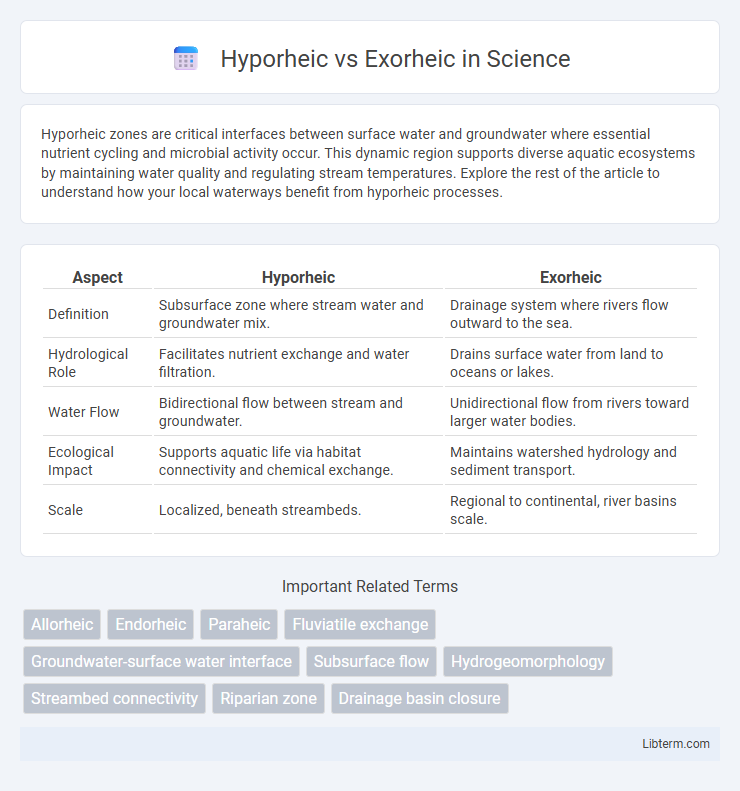Hyporheic zones are critical interfaces between surface water and groundwater where essential nutrient cycling and microbial activity occur. This dynamic region supports diverse aquatic ecosystems by maintaining water quality and regulating stream temperatures. Explore the rest of the article to understand how your local waterways benefit from hyporheic processes.
Table of Comparison
| Aspect | Hyporheic | Exorheic |
|---|---|---|
| Definition | Subsurface zone where stream water and groundwater mix. | Drainage system where rivers flow outward to the sea. |
| Hydrological Role | Facilitates nutrient exchange and water filtration. | Drains surface water from land to oceans or lakes. |
| Water Flow | Bidirectional flow between stream and groundwater. | Unidirectional flow from rivers toward larger water bodies. |
| Ecological Impact | Supports aquatic life via habitat connectivity and chemical exchange. | Maintains watershed hydrology and sediment transport. |
| Scale | Localized, beneath streambeds. | Regional to continental, river basins scale. |
Introduction to Hyporheic and Exorheic Systems
Hyporheic systems refer to the subsurface zones beneath and alongside streams where surface water and groundwater mix, playing a crucial role in nutrient cycling and habitat diversity. Exorheic systems are characterized by drainage basins that discharge water directly into oceans or seas, supporting extensive river networks and influencing large-scale hydrological processes. Understanding the dynamics between hyporheic exchange zones and exorheic drainage patterns is essential for effective water resource management and ecological conservation.
Defining Hyporheic Zones
Hyporheic zones are subsurface regions beneath and alongside stream beds where surface water and groundwater mix, supporting unique biogeochemical processes. These zones play a critical role in nutrient cycling, organic matter decomposition, and habitat diversity within freshwater ecosystems. Unlike exorheic systems that drain surface water to oceans, hyporheic zones represent transitional interfaces crucial for maintaining stream ecological integrity.
Understanding Exorheic Systems
Exorheic systems are characterized by surface water drainage that flows directly into oceans or seas, forming distinct river networks with clear outlets. These systems support efficient sediment transport and nutrient cycling due to their open basin structures and continuous water flow. Understanding exorheic dynamics is crucial for water resource management, flood control, and ecological conservation in continental drainage basins.
Key Differences Between Hyporheic and Exorheic
Hyporheic zones refer to the subsurface regions beneath and alongside streambeds where surface water and groundwater mix, facilitating nutrient exchange and supporting diverse microbial life, while exorheic basins are drainage areas where surface water flows to external bodies like oceans or lakes. Hyporheic systems influence stream ecology and biogeochemical cycles by mediating water quality and temperature, whereas exorheic systems are critical for large-scale hydrological routing and sediment transport. The key difference lies in hyporheic being a localized subsurface flow zone enhancing ecological processes within streams, contrasted with exorheic basins encompassing extensive surface drainage networks discharging water externally.
Hydrological Processes in Hyporheic Zones
Hydrological processes in hyporheic zones involve the exchange of surface water and groundwater through porous sediments beneath and alongside streambeds, promoting biogeochemical reactions and nutrient cycling. These zones differ from exorheic systems, where surface water flows continuously toward oceans or lakes without significant subsurface mixing. The dynamic water exchange in hyporheic zones plays a crucial role in regulating stream temperature, oxygen levels, and habitat diversity, enhancing ecosystem health and resilience.
Ecological Functions of Exorheic Systems
Exorheic systems drain water from terrestrial ecosystems directly to the ocean, supporting diverse aquatic habitats and nutrient cycling processes. Their ecological functions include maintaining water quality by transporting organic materials and pollutants, sustaining fish migration routes, and regulating flood regimes across connected river networks. These systems enhance biodiversity by linking upstream and downstream habitats, facilitating species dispersal and genetic exchange.
Importance for Aquatic Ecosystems
Hyporheic zones, where surface water and groundwater interact, play a crucial role in maintaining water quality and supporting diverse microbial and invertebrate communities essential for aquatic ecosystems. Exorheic systems, characterized by surface water flowing to the oceans, are vital for nutrient transport, sediment distribution, and sustaining fish migration routes. Both hyporheic and exorheic processes influence habitat connectivity, biogeochemical cycles, and overall ecosystem health in freshwater environments.
Human Impacts on Hyporheic and Exorheic Processes
Human activities such as urbanization, agriculture, and industrial pollution significantly alter hyporheic zone functions by disrupting sediment permeability and nutrient cycling, leading to reduced groundwater-surface water interactions. In exorheic systems, dam construction, water extraction, and channel modification affect river flow regimes and sediment transport, causing habitat fragmentation and altered downstream ecosystems. These anthropogenic pressures compromise water quality and ecosystem services in both hyporheic and exorheic environments, highlighting the need for integrated watershed management approaches.
Applications in Environmental Management
Hyporheic zones play a critical role in nutrient cycling and water purification, making them essential for restoring river ecosystems and managing groundwater-surface water interactions. Exorheic basins, characterized by external drainage to oceans, are integral to managing large-scale watershed health, flood control, and sediment transport. Understanding these systems supports targeted strategies in water quality improvement, habitat conservation, and sustainable resource management.
Future Research Directions and Challenges
Future research in hyporheic and exorheic systems should prioritize advanced hydrological modeling techniques to better predict water flow and nutrient cycling under climate change scenarios. Challenges include integrating multi-scale data from remote sensing and in situ measurements to capture dynamic interactions between surface and subsurface processes. Enhancing understanding of biogeochemical exchanges in hyporheic zones will improve river basin management and ecosystem resilience in exorheic landscapes.
Hyporheic Infographic

 libterm.com
libterm.com